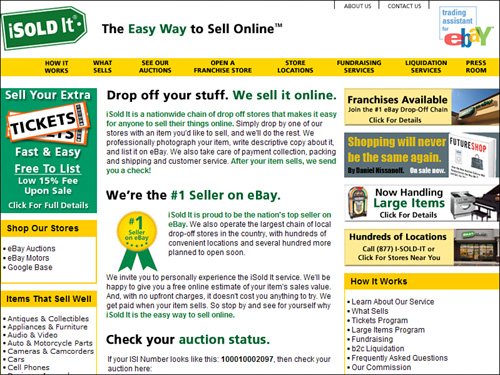Setting Up Shopand Setting Prices
| Once you've joined eBay's Trading Assistant program, it's time to set up your businesswhich is as simple as establishing a selling procedure, writing up a contract, and then going out and finding clients. Let's take a quick look. Create a Consignment ContractAll serious Trading Assistants should create a contract for their clients to sign. This contract spells out exactly what it is you are and are not responsible for, and clarifies your legal position in terms of ownership of the product. Your contract should include the following items:
Obviously, both you and your client need to sign this contract before you can begin the selling process. Set Your Fee ScheduleAs a Trading Assistant, you make your money from the fees you charge for your services. There are no set guidelines for these fees; you can charge pretty much whatever you want, or whatever the market will bear. First, consider establishing a flat fee of $5 or $10 for every transaction, in addition to a selling commission. This fee, typically paid up front, ensures that you get paid something whether the item sells or not. It also helps to weed out lower-priced and lower-potential items; if clients have to pay a little up front to get in the game, they might think twice about the salability of what they bring to the table. As to the selling commission, you'll find sellers charging anywhere from 10% to 50% of the final selling price. The average fee seems to be in the 25% range. That is, you take 25% of what the item sells for; if you sell an item for $100, your fee is $25. Then you have all the various eBay and PayPal fees to consider. Most consignment sellers pass on these fees to the client, in the form of additional charges. So on your $100 item, you'll take out your $25, plus eBay's listing and final value fees, plus the PayPal or merchant credit card fees (if any). Consider Opening a Drop-Off LocationMany eBay Trading Assistants work out of their home. If you go this route, you'll either have to pick up items from your clients' homes or have your clients drop off items at your home. While some clients might like this homey touch, others might be a little nervous about dealing with a business that doesn't look like a business. Note
A more professional (and more expensive) option is to rent your own retail storefront for merchandise drop-offs. Chances are you'll attract more clients with a drop-off location, and not only because your signage will provide added visibility; many people will be more comfortable leaving their merchandise at a retail location than at some stranger's house or apartment. You also get lots of added space to store the consigned merchandise and conduct your business. The downside of this, of course, is you have additional coststhe rent and utilities for your store, plus signage and the like. And you'll pay those bills every month, no matter how much auction business you do. But you don't need a big store, and it doesn't have to be in a high-rent location. Any type of storefront or office space will do. Go the Franchise RouteAnother option is to buy into one of the several eBay drop-off franchise operations that are starting to bloom. With a franchise you get lots of help getting started; the main office will help you choose a retail site and negotiate your lease, plan your store layout, and market your operation. You'll also get training and ongoing operations support, plus the value of the franchise name. For all this, you pay a large upfront fee and a percentage of your monthly revenues. Is a franchise a good idea? Maybe, especially if you're new to this or generally inexperienced in running a business. Maybe not, if you're an experienced seller, know how to run a business, and prefer to work for yourself (and keep all the profits yourself). If you're interested in doing the franchise thing, definitely check out several different franchises, visit a few of the stores, and talk to some of the franchise owners. Know what you're getting into before you sign that first check. Some of the more popular eBay drop-off franchises include
Figure 29.2. The home page for the iSold It franchise. Remember, before you enter into any franchise agreement, do your homework: Check out the franchisor's finances and history, talk with other franchisees, and compare franchise fees with other franchises. |
EAN: 2147483647
Pages: 204
